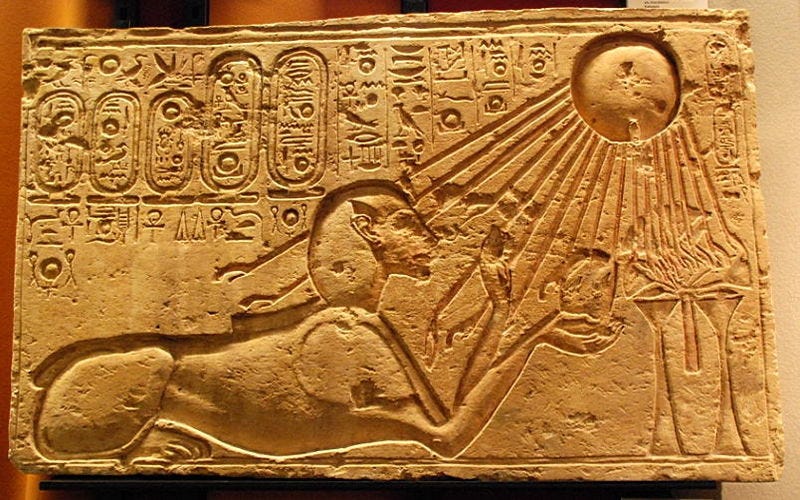Unveiling Akhenaten’s Rebellion: A Revolutionary Chapter in Ancient Egyptian History
Prepare to venture into a lesser-known chapter of ancient Egyptian history as Top Ten Egypt invites you to explore the remarkable rebellion led by Pharaoh Akhenaten during the 14th century BCE. This captivating era witnessed a groundbreaking shift in religious beliefs, as Akhenaten sought to establish monotheism as the dominant faith in Egypt. Join us as we delve into the intriguing story of Akhenaten’s rebellion and the profound impact it had on ancient Egyptian society.
Akhenaten, originally known as Amenhotep IV, ascended to the throne during the New Kingdom period. He ushered in a period of radical transformation, challenging the established polytheistic religious practices and steering Egypt toward a monotheistic ideology centered on the worship of the sun disk deity, the Aten.
A Revolutionary Vision: The Origins of Akhenaten’s Monotheistic Beliefs
Akhenaten’s revolutionary beliefs can be traced back to his early encounters with the temple of the sun god, Amun-Ra, in Thebes. Inspired by a profound spiritual experience, he became convinced of the existence of a singular, all-encompassing deity – the Aten. Determined to elevate this newly discovered divine entity, Akhenaten launched a religious and political revolution that would reshape the religious landscape of ancient Egypt.
In his pursuit of monotheism, Akhenaten sought to undermine the traditional religious institutions and symbols associated with the pantheon of Egyptian gods. Temples honoring Amun-Ra and other deities were closed, and the worship of the Aten became the central focus of religious life.
Building a New Capital: Akhetaten, the City of the Aten
To reinforce his religious reform, Akhenaten initiated the construction of a new capital city known as Akhetaten, or the Horizon of the Aten. Situated in present-day Amarna, this city served as an embodiment of his revolutionary vision and a testament to the power of the Aten. Akhenaten relocated the royal court, administration, and religious center to Akhetaten, distancing himself from the traditional power centers and breathing life into his monotheistic ideology.
The city of Akhetaten was characterized by a distinctive architectural style. The temples and palaces, adorned with reliefs and sculptures depicting Akhenaten, his family, and the Aten, showcased a departure from conventional artistic norms. The art and architecture of Akhetaten reflected the pharaoh’s desire to create a new aesthetic that aligned with his religious and political beliefs.
Rebellion and Resistance: The Challenges Faced by Akhenaten’s Reign
Akhenaten’s religious revolution did not come without opposition. The radical departure from centuries-old religious traditions and the concentration of power in the hands of the pharaoh challenged the religious and political establishment. The priesthood and other influential factions resisted Akhenaten’s reforms, viewing them as a threat to their vested interests.
Moreover, as the pharaoh shifted his focus away from external affairs, Egypt faced political and military challenges. The empire’s power and influence waned, and tensions with neighboring kingdoms grew. Akhenaten’s obsession with religious reform contributed to a decline in Egypt’s international standing.
Legacy and Impact: Reflections on Akhenaten’s Historic Rebellion
Although Akhenaten’s reign was relatively short-lived, lasting for approximately 17 years, its impact on Egyptian history and society was profound. His rebellion laid the groundwork for monotheism in ancient Egypt, foreshadowing the rise of subsequent monotheistic faiths in the centuries to come.
Despite the subsequent attempts to erase the memory of Akhenaten and his reforms, his efforts left an indelible mark on Egyptian culture. The art and architecture of the Amarna period continue to captivate scholars and visitors, offering a glimpse into this unique era of religious and artistic expression.
As we reflect on the transformative rebellion of Pharaoh Akhenaten, we gain a deeper appreciation for the power of ideas to shape history. Akhenaten’s bold vision for a monotheistic Egypt challenged the established religious order and left an enduring legacy. His radical reforms, the establishment of Akhetaten, and the struggle to overcome resistance offer an intriguing narrative that sheds light on the complexity and diversity of ancient Egyptian history. Let us celebrate the rebellious spirit of Akhenaten, appreciating the profound impact his insurgency had on the religious and cultural landscape of ancient Egypt.



Comment (0)